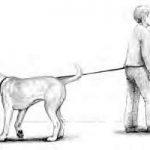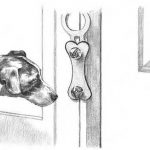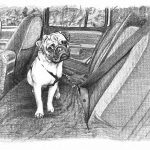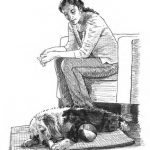Families with children want to ask whether the pups have been kid-proofed. Even childless people usually have friends or family whose youngsters visit. And families with one or two well-behaved children often have a half-dozen others running in and out the door, sometimes not as quiet and mannerly. Pups need be exposed to household noises, screeching kids, and wrestling mania if those sounds are to be part of their future life.
A bad breeder doesn’t care what you’re going to do with the dog, as long as your check clears. A good breeder genuinely loves her pups and wants to make sure that they all have a good lifelong home. Expect good breeders to ask you the following questions:
Now, are you ready to buy the pup? Is this place the right one? Think, because this will be your final answer.
Ironically, popularity often sounds a breed’s death knell. Opportunists looking for a quick buck leap into dog breeding to satisfy the desires of pet buyers. Without knowledge of genetics and good breeding practices, the mass-produced misfits are plagued with health and temperament problems. These junkyard dawgs are lost causes when the wind changes direction. To avoid buying trouble, be sure to deal with a reputable breeder.
When you get a dog from a reputable breeder, you can be confident that the dog’s best interest has always been at heart. Most breeders breed dogs because they love them, not because they’re trying to make a quick buck. An average litter of medium-sized dogs produces about five or six pups. Many breeders plan a litter to keep one pup for themselves and/or provide one for a previous buyer. That leaves four or five for sale. Breeder expenses for raising a litter in a caring, nourishing, and healthy environment include the following:
Diggin’ That Doggie in the Window
Many pet stores have stopped selling dogs and cats, preferring to deal with inanimate merchandise that doesn’t require the care that live animals do. To encourage placements, some of the largest chains conduct “adoption days,” when dogs from local shelters are brought into the store. The wannabe pets are tidied up and often sport bandanas around their necks to add to their appeal. Volunteers may teach the dogs basic manners or maybe a few tricks, putting them through their repertoire for visitors.
Identifying a conscientious pet store
A few pet stores, however, continue to sell puppies that are obtained from various sources — either a local owner who was unable to place the puppies or a broker for a larger commercial enterprise. Although puppies are hard to resist and seem to magnetically attract attention, be sure that the store where you shop has a caring staff with adequate time to spend holding or playing with the puppies. Puppyhood is the crucial age for developing social skills.
Warning!
Pet store prices are usually more than a breeder’s price, and the puppies are more often sick.
Getting the best from a pet store
If you decide to buy from a pet store, be sure to ask the same questions you would if you were buying a pup from a breeder (listed earlier in the chapter). Try to think with your mind rather than your heart. Everyone’s first impulse is, “Aw, let’s buy him.” You must do a few things before cuddling the pup, though (remember, cuddling is a surefire sales gimmick):
– Ask to see the puppy’s registration form and health certifications for the parents.
– Check the guarantee.
– Obtain copies of all paperwork stating that the pup is in good health, has been checked for parasites, and has received his initial inoculations.
– Ask for the breeder’s contact information. Call the breeder to ask pertinent questions.
Puppy
Don’t buy a puppy that is younger than 8 weeks of age. For one thing, doing so is illegal in most states. For another, puppies need to be with their littermates to develop bite inhibition and social skills. Younger puppies have less control of their bowel and bladder functions and are more difficult to housetrain. Ask the pet store how long the puppy has been there. A pup may be 8 weeks old but was taken away from his mother and littermates two weeks before, which is problematic from the standpoint of social skills.
Warning!
If you buy a dog from a pet store, make a veterinary appointment ASAP — within 24 hours. Store refund or replacement policies are often in effect only within 24 to 48 hours of the purchase. Returning an ill puppy is not always easy emotionally, but don’t set yourself up for far greater heartbreak by taking a sickly pup under your wing.
Watching out for unchecked commercialismBuyers want a puppy who’s been raised with love. People who love their dogs raise them with kindness and the best care they can give. It’s nearly impossible to give adequate care, let alone loving attention, to 50 or more animals. Yet one commercial breeder boasts of supplying semis full of puppies to stores — at a rate of 900 a week! If an owner with 50 dogs spends 12 hours a day with his dogs, that still is only 14 minutes per dog, which isn’t enough. You want to buy a dog from someone who understands the breed and can help you with any questions or problems that may arise. You want a puppy who’s been raised in clean conditions, not in crates or small cages, sleeping among urine and excrement. You want a pup who knows that a raised hand means it’s going to be kissed and cuddled, not smacked or poked. |
Adopting an Orphan
Some shelters have the same rigorous requirements that breeders do. They may not place certain dogs in homes with small children, or they may require a fenced yard. They want the animal to have a second chance at a great home. Ask if you can bring other family pets to the shelter for a preadoption visit to see whether the current and future buddies tolerate each other. A few shelters require a 24-hour waiting period to ensure that the adopter is not acting on a whim and is sincere about wanting the animal.
Adoptive families need to ask whether any history is known about the dog. Some dogs are surrendered by previous owners. Reasons can vary from a move or divorce to a behavior that is impossible for one family to tolerate yet is considered a bonus to another. If the dog has been in the shelter for more than a few days (most strays are kept long enough to be vet-checked and to allow the lost owner a chance to be found), managers and employees will be able to provide you with helpful information. They’ve probably observed whether the dog barks a lot or is friendly, timid, or trained.
Most people want a dog who is friendly and calm, yet playful. Choose one who sparkles with good health. Most shelter dogs have something negative in their history, even dogs who were surrendered unwillingly because of the owner’s poor health or circumstances. A dog who appears unsure of herself in a shelter can bloom with confidence after a week or so of doting love and kindness. But one who is bouncing off the walls in unfamiliar surroundings usually requires someone who is at least as energetic and determined as the dog. Either can reward you with great joy if you choose with care.
Shelters have various adoption fees and procedures. Fees are often $50 to $75, which may include a rebate when the pet is spayed or neutered — they don’t want to place one animal only to receive eight in its place. Some shelters participate in early spay/neuter programs so that dogs are already altered (“fixed”) before they are adopted. Others offer referrals to clinics that perform the surgery at a reduced fee. The more responsible shelters follow up on adoptions, making sure that the dog is altered and in a good home. Shelters occasionally have lists of local clubs or breeders who are willing to provide you with tips about your breed.
Buying from Afar
How do you buy a puppy 1,000 miles away? It happens all the time. But if you cannot see the pups personally, breeders should be willing to send you pictures of the parents and pups. With today’s technology, they may send pictures and video over the Internet. Trusting that the breeder has good ethics is especially important when buying sight unseen.
Getting the ball rolling
Initial contacts come through e-mail or phone calls. Once in a while, the courtship is conducted through letters (although, frankly, the response to a letter is usually much slower and sometimes nonexistent). Ask whether the breeder has a litter or plans one in the near future. You’ll have dozens of questions to ask the breeder, and don’t be surprised when you receive just as many. (See the sections on questions to ask and answer earlier in this chapter.)
When you feel a connection with this person you haven’t met, you’ll probably talk many times before Baby comes bouncing into your home. Preliminary mailings usually include photos of the sire and dam, their health clearances, pictures of past puppies, and information about kennels. You may also get info about the breed and guidelines on teaching manners, crate training, housetraining, and more.
Tip
While you’re waiting for a litter, or while you’re still trying to narrow your choices, ask the breeder to send photos or videos of the extended family and puppies as they grow. It’s sure to either help you make up your mind or endure the waiting period, depending on your situation.
Making travel plans
Many buyers are willing to drive any distance within six to eight hours to avoid shipping. Beyond 500 miles, unless you’re into long, long drives, your puppy likely will be shipped to you. Flying to the breeder and bringing your puppy back as under-the-seat baggage is the best way — unless, of course, you’re buying a Newfoundland, which would have to travel in the cargo hold. Medium-sized or smaller breeds fit well.
Tip
Otherwise, the next best way to fly your puppy home is to have her marked “priority” or “counter-to-counter,” meaning she’ll be the last loaded into baggage and the first off. Make sure that you book a direct flight, even if you have to drive to a larger airport, so that your puppy doesn’t have to change planes. Breeders know all the best ways of handling transportation — consult them on the details. They want to ensure that their precious bundle of joy arrives safely in your hands.
Adopting a Rescue or Ricochet Dog
Maybe canine blue blood or registry doesn’t mean anything to you. If that’s the case, many delightful dogs are available through purebred rescue organizations and animal shelters, both staffed with dedicated volunteers who do their darnedest to help canine throwaways. Most rescue organizations focus on helping a breed of choice.
Animal shelters, on the other hand, draw no such lines. Big/small, young/old, pure/mixed — they’re all the same in their eyes: homeless dogs.
Dogs may end up homeless for many reasons:
– Dogs are credited with helping their people to be healthier in mind and body. Unfortunately, it doesn’t mean a person will live forever, and sometimes an owner dies.
– Broken homes are a dismal part of today’s statistics, and when they occur, the pet can wind up with no home at all.
– People may become incapacitated and can no longer take care of a dog.
– A dog may accidentally escape and not be reclaimed.
– A move can mean that an owner cannot take an animal along.
101 unwanted DalmatiansThe popularity of the Dalmatian soared to great heights following Disney’s feature films and then plunged to Titanic depths when buyers found that these cute little spotted pups grew up and actually behaved like real dogs rather than cartoons. Although the Dalmatian Club of America strove mightily to warn people that no dog is appropriate for everyone, many Dalmatian owners decided that their ship was coming in and this was the time to set sail into Breeders’ Land. Dalmatian pups sold like popcorn at the movies and later were discarded like the empty boxes. Greasy cardboard is easily cleaned up . . . not so for living creatures. Dalmatian rescue |
Face it, people (especially people who don’t read this book) make mistakes and form bad decisions about pet ownership. Lifestyles change, and sometimes owners realize that, as much as they love their dogs, their pets need more attention than they can give at particular stages of their respective lives. So for all sorts of reasons, dogs can become homeless.
Some buyers think that they want to start with a puppy so they can mold his character and train him to be the kind of dog they want to live with — or, at least, claim his bad habits as their own creation. However, not everyone wants the “blessings” of puppyhood, so they consider a recycled adult.
Elderly dog lovers often think they’re no longer capable of training or keeping up with an energetic young pup. Sometimes they also think restricting a young dog to a more sedate, leisurely lifestyle isn’t fair. And occasionally, senior citizens fear their dog will wind up an orphan if Father Time sounds the quitting whistle for them. Thus, an elderly dog can be just the right soul mate for the winter of both their lives.
However, not all homeless dogs are adults — sometimes baskets of foundlings are left at the doorsteps of shelters — although most surrendered dogs are at least several months old. The saddest of all these victims of society are the older dogs, with their grayed muzzles and bewildered eyes, not understanding why they’ve become canina non grata.
The greatest numbers of homeless dogs are dogs reaching puberty, at approximately 1 year of age. At that age, the cuteness of puppyhood is starting to wear off and the novelty of dog ownership is becoming a chore. Longhaired dogs are at their worst coat stage, with mats forming by the minute. Hormones are surging in those dogs who still are intact, and like human teenagers, they sometimes act out their bodily urges and mental anguishes. But dogs can find themselves in need of a home at virtually any age.
Rescues: Giving a Home to the Hopeless
Sadly, too many dogs find their way to animal shelters and Humane Societies. However, networks of dedicated dog lovers (some are breeders) do all they can to rescue as many of these hapless pooches as possible and place them in new homes.
Most breeders love all dogs, particularly their own chosen breeds. Breeders who are active in rescue check out strays or dogs who have been surrendered at Humane Societies. Rescuers examine them to determine whether the dog can be placed or whether she has unsolvable mental or physical problems. Almost all national parent clubs support rescue organizations for their breeds.
Rescue organizations don’t want repeat offenders. They’d just as soon place the dogs in the right home to begin with. They’ll ask as many questions as breeders and make certain emands on the adopters. In fact, they may even be more particular because they know the dog already has been subjected to abuse, neglect, or abandonment and they want to avoid further trauma for the dog.
Rescue associations will conduct follow-up visits and interviews to make sure that the dog (and you) are adjusting to each other. Because they know the breed so well, they’ll be available to give advice when you need it.
These organizations stay afloat mainly through donations given by grateful adopting families and from club members devoted to helping their breed. Rescuers are not paid for their efforts and, in fact, often donate their expenses as well as their time.
Understanding how rescue systems work
A national coordinator solicits help from club members or regional assistants (sometimes even calling upon experts in other breeds) to identify the dog as a purebred. Foster homes are found; healthcare is provided. Almost without exception, the dogs are spayed or neutered if they are intact. They’re debugged and dewormed.
Some individuals — like Beardie lovers — help out Neardies when possible. (A Neardie is a dog with a lot of Beardie in him — he’s nearly a Beardie.)
During foster care, the dogs’ hungry tummies are filled with good food, and they’re also nourished mentally with the love and attention they hunger for. They gain weight and regain health. Matted dogs often must be shaved or shorn. It can be humorous to watch a formerly filthy, dejected beastie strut in style after a session with a groomer.
Tip
Want to “try on” a breed? Volunteer to foster a dog until a home can be found (or the dog becomes your permanent resident).
Foster families carefully observe their charges for behavioral and temperament problems. Breed rescues operate on a shoestring and can’t afford to be sued for placing a vicious animal. Nor do the volunteers want anyone to be injured. But what one family can’t tolerate may be exactly what another person is looking for. Matching the dog to the family is of prime concern. Dogs who are too rowdy for young children or elderly people often fit the bill for a family with teenagers. Timid dogs are happy to curl up in the lap of a quiet adult.
When the dogs’ bodies and minds are healed, the adoption process begins. Transportation can be provided, through an “aboveground railroad,” shuttled by dog lovers across the country, if need be, to a new home.
Recognizing who gets rescued
The lucky breeds have waiting lists for rescues. With more populous breeds, however, dog lovers make desperate efforts to save all they can, but knowing so many dogs’ lives are lost is disheartening, even though those dogs have done nothing wrong except be in the wrong place at the wrong time. Dedicated rescuers struggle on, saving one dog at a time, as in the story about the little boy who saved one starfish by placing it back in the ocean. He knew he couldn’t save them all, but he could save that one.
Rescue organizations can be located through the national clubs of the various breeds, which you can find by contacting one of the registering bodies, such as the AKC or UKC. Several breed rescues have Web sites that you can easily access by using your favorite Internet search engine.
Rehoming Ricochet Dogs
Breeders want one thing above all: a forever, loving home for each of their puppies. Sadly, it doesn’t always work out that way. No matter how much effort a breeder puts into interviewing buyers and finding the right homes, occasionally the unexpected happens.
Ricochet dogs are dogs whom owners return to the breeder for whatever reason. Placing these ricochet dogs in new homes is called rehoming. Conscientious breeders who love their dogs always welcome their pups back — at any age — if they ever need to be placed again. In fact, they usually stipulate this requirement in the sales contract.
Breeders hate to make mistakes in matchmaking, and they hate that the dog must adjust to returning to his birthplace and again to a new (and, hopefully, permanent) home. But taking these dogs back is one of the obligations breeders assume when they bring puppies into the world.
A breeder generally hears the words “I can’t keep him” with a sinking feeling in the abdominal pit. Yet no matter how a responsible breeder has to shuffle other dogs or her own life, her immediate response is, “Bring him back.” She sets another place at the table and throws another burger on the barbie.
Ricochet dogs may be any age. If they’re elderly, they usually join the pack in the home where they were born. If they’re sickly, the breeder may have to bite the bullet and face the difficult choice of euthanasia.
Most, however, are rehomed through the breeder’s waiting list and rescue network — which have been expanded and made even swifter by the Internet. Many breeds have electronic lists that their breed lovers can subscribe to, and word passes quickly.
One advantage of obtaining a ricochet dog from a breeder is being able to ascertain the health of the parents and having access to health records. The breeder’s knowledge of the dog’s ancestors also is helpful.
Owners and breeders need to prepare for the unexpected and plan in advance for what-if scenarios. Never collect or produce more dogs than you (or a relative or friend) can comfortably house, at least temporarily.
Finding Restful Homes for Retirees
Breeders have busy lives. They also usually have a menagerie of puppies, young show prospects, brood matrons, stud dogs, and golden oldies. Sadly, Grams and Gramps may receive the least attention, just because their needs aren’t as immediate. Old dogs usually fit in well. They’re used to routines and often are content with snoozing on the couch.
Because former stars of the show ring and whelping box are less demanding, they’re fed, watered, vetted, and petted, but they’re only one of the pack. Although heart-wrenching, some owners think their oldies deserve individual attention and that placement in a one- or two-pet home is better for the dog, so they’re willing to place them in new homes.
Mixed breeds offer many charmsOne advocate of mixed breeds says, “I want one of these and one of these and one of those . . . and I think that’s why I end up with mixes. That way you get them all, one way or another. I say that’s part of the charm of a mixed breed: You don’t know exactly what you’re getting, it’s unique, and you’ll never again have one just like that.” Many buyers have a breed or two or ten in mind. But if you simply want a pet who will love you, you may find the perfect dog waiting for you at a pound, shelter, or Humane Society. As many as 25 percent of shelter inmates may be purebred, but the other 75 percent — mixes — need homes, too. Just choose carefully. Dog lovers want to empty shelters, not fill them. |
Not all retired dogs are old. Many are middle aged but have retired from a breeding program. Males can stand at stud for several years, but females often are spayed after three or four litters (at about the age of 5 or 6). Thus, most retirees are females.
Tip
Retirees can be great choices for people who are too busy to train puppies (or who’ve been there, done that, and don’t want to do it again). Many of these animals are former show dogs and thus are well-trained, outstanding examples of the breed.
Sorting through Shelter Stats
The world would be a perfect place if everyone, human or canine, had a loving home. Sadly, until all breeders carefully plan litters and judiciously place puppies, and all buyers choose wisely, shelters will always overflow with unwanted dogs. While some of these homeless dogs are purebreds, many others are mixed breeds.
Shelter statistics indicate that adopters most often choose small or medium-sized, fluffy, purebred puppies. So a larger, short-haired, mixed-breed adult has the least chance of being adopted. Yet such a dog just may be the perfect one for you.
Some dogs are known to be half of one breed and half of another. Others are so obviously indiscernible that they’re called Heinz 57 because many varieties of dogs may be adding their genes to the mix. If the ancestry is known, some guesstimate may point to the instincts and proclivities of the individual. Maybe she’ll be a good retriever like her Chessie mom and aristocratic like her Pekingese dad. Then again, maybe she’ll just join you in the bathtub and under the hair dryer now and then.
Considering Pup’s Early Environment
Puppy
When you’re trying to decide on a canine companion, consider not only his future with you, but also the environment of the dog’s puppyhood. When you can, watch how the breeder interacts with the litter. If the pups greet him with glee, eagerly welcoming pats and attention, they’ve been handled with love and are well socialized. Eyes sparkle with health and fur shines (though they may have just somersaulted through a puddle on the way to meet you).
Some owners tuck the whelping box (where pups usually spend their first four to five weeks) in a corner of a room. Not everyone, however, has space for this arrangement. The nursery may have been in a simple unadorned kennel, basement, or garage, but it needs to be clean, comfortable, and visited by people several times a day.
Puppy
Breeders can’t acclimate pups to every noise, creature, or contraption that they’ll meet in life. However, exposing pups to a loud radio, slamming doors, and a dropped pot now and then can alleviate future trauma. Baths, collars, car rides, and nail clipping need to be part of a pup’s background by the time he’s ready to depart the nest.
Tip
When searching for your pup, ask about health. Individual lines differ, but in most cases, health clearances are for the parents rather than the puppies. So don’t expect your pup to have certificates of health. A few tests, such as heart and juvenile cataract exams, can be conducted in puppyhood. Talk to a veterinarian about what to look for in your chosen breed. See the chapters in Book Dog Nutrition and Health for a lot more on health concerns.
Timing Your Adoption
Good breeders won’t permit a pup to go home with a new owner on a child’s birthday or a major holiday, particularly at Christmas — with rare exceptions (such as to homes with one or two adults planning a quiet celebration in front of the fireplace). Holidays are hectic enough, with parties to attend, visitors popping in, shopping to finish, and popcorn to string. Pups are likely to be underfoot, putting an extra demand on time. If you want to surprise the kids with a pup, plan ahead by asking the breeder for a picture of the pup (or the parents). Wrap a bowl, brush, leash and collar, and box of dog biscuits. Buy books about the breed, training, and even puppy names.
Getting a dog from a neighbor or colleagueNeighbors, co-workers, and acquaintances whose dogs have puppies can suddenly become your best friends. If the litter is unplanned (except by the two guilty parties), the owners may be desperate to place the little critters who eat and eliminate copious amounts of food. People who give away pups for little or nothing aren’t motivated to invest a lot in their care. Anyone can be a breeder — not everyone is a good breeder. |
Tip
Unfortunately, breeders can’t arrange litters during the prime times for buyers. Pups are born throughout the year (in fact, usually during the most inconvenient times). Begin your calls several months before you’re ready because finding the perfect pup often takes a few weeks or months. If you want a pup in the summer, start calling in the winter. Litters are often reserved before they’re born or shortly afterward.
When You’re the Matchmaker: Stray Dogs
Occasionally, you don’t choose the dog; the dog chooses you. One morning you open the door and there, smiling his way smack into your heart, is your new dog. Or you’re driving down the road and run into (but not run over, as long as his guardian angels are watching out for him) the saddest story in dogdom: a dog who has been abandoned and is hopelessly searching every face in every car for his erstwhile loved one.
Remember
If you give your heart and your home to a stray, whether purebred or mongrel, you’re performing a good deed, serving as a lifesaver for the dog, who’d otherwise likely end up as a pound stat or roadkill. Adopting a foundling also is a good deed for society because your dog won’t be a canine criminal, chasing and destroying farm stock. The rescued foundling won’t bite-and-run, dirty the streets, strew garbage, or haplessly spawn more happenstance homeless canines.
Some homeless dogs are on the streets through no fault of their own. Others are there because of behavior problems or uncurbed instincts that urge them to Run! Chase! Bark! Their previous owners hadn’t bothered to channel those instincts or found it difficult to do so. Although most animals (again, like their human counterparts) are on good behavior while settling in, once settled, they show their true habits. Within a matter of days — or surely weeks — of adopting a stray, you may have to decide whether the conduct is something you can live with or whether it’s something you’re willing to work with and train into acceptable behavior.
If you decide you cannot live with a particular problem, take the dog to a shelter. Be truthful about the particular bugaboo. If the person to whom the dog is surrendered has an idea of what the annoying behavior is, placing the dog in a suitable home or retraining it still may be possible. Don’t replay the abandonment story the dog has already suffered once. The final chapter of that book always is a sad one.
Although taking in a stray dog is the least expensive way to obtain a pet, it bears mentioning that because Fido doesn’t come bearing medical records, he’ll need a complete work-up at the vet’s office.
Whether the story has a happy ending for you, however, only time will tell. When you’re unsure of the environmental circumstances and genetic influences molding your dog’s temperament, you’re groping in the dark, unable to see what’s ahead. If that’s what your heart tells you to do and you’re prepared to face and conquer problems, bless you. But if you think that taking in a stray is an inexpensive way to obtain a pet, it does neither you nor the dog any good to rerun this scenario.
by Eve Adamson, Richard G. Beauchamp, Margaret H. Bonham, Stanley Coren, Miriam Fields-Babineau, Sarah Hodgson, Connie Isbell, Susan McCullough, Gina Spadafori, Jack and Wendy Volhard, Chris Walkowicz, M. Christine Zink, DVM, PhD


































